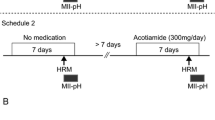Abstract
Introduction
Upper gastrointestinal discomfort is common in renal failure patients, whether on dialysis or not, leading to malnutrition. Nitric oxide is a known neurotransmitter of the gut and may have a role in the pathogenesis of upper gastrointestinal discomfort. So, we aimed to study the role of nitric oxide in gastroesophageal motility in chronic renal failure patients.
Patients and methods
The study included 60 patients with chronic renal disease and 20 healthy individuals as a control group. Patients were divided into 3 groups. Group 1: 20 patients with chronic renal failure with creatinine clearance between 20 and 40 ml/min. Group 2: 20 patients with end stage renal disease (creatinine clearance <10 ml/min) just before the start of hemodialysis. Group 3: 20 patients on regular hemodialysis, Group 4: 20 healthy individuals as a control group. For all groups, full history and clinical examination, routine laboratory investigations, creatinine clearance, serum Nitrate levels an index of in vivo nitric oxide generation, esophageal manometry and electrogastrogram were done.
Results
Serum nitric oxide was significantly higher in patients with chronic renal failure than in healthy controls (P < 0.001). Number of cases showing esophageal manometry abnormalities was significantly higher in patients with chronic renal failure than in control group (P < 0.001). There was significant association between the manometric based diagnosis and nitric oxide in chronic renal failure patients, so, the highest level of nitric oxide was found in cases of aperistalsis. Number of cases showing abnormal elrctrogastrogram was significantly higher in patients with chronic renal failure than in control group (P < 0.007). Significant, weak negative linear correlation was found between nitric oxide and dominant frequency in patient groups, so, nitric oxide level was higher in bradygastric than in tachygastric cases.
Conclusion
Serum nitric oxide is disturbed in end stage renal disease whether patients are on dialysis or not. The disturbed serum level of nitric oxide is associated with upper gastrointestinal dysmotility, which in turn may affect nutritional status of chronic renal failure patients and hence affects morbidity.


Similar content being viewed by others
References
Bird NJ, Streather CP, O’Doherty MJ, Barton IK, Gaunt JI, Nunan TO. Gastric emptying in patients with chronic renal failure on continuous ambulatory peritoneal dialysis. Nephrol Dial Transplant. 1994;9(3):287–90.
Kao CH, Hsu YH, Wang SJ. Delayed gastric emptying in patients with chronic renal failure. Nucl Med Commun. 1996;17:164–7.
Brune B, Zhou J, et al. Nitric oxide, oxidative stress, and apoptosis. Kidney Int, Suppl. 2003;84:S22–4.
Shah V, Lyford G, et al. Nitric oxide in gastrointestinal health and disease. Gastroenterology. 2004;126(3):903–13.
Guarner C, Soriano G, Tomas A, Bulbena O, Novella MT, Balanzo J, et al. Increased serum nitrite and nitrate levels in patients with cirrhosis: relationship to endotoxemia. Hepatology. 1993;18(5):1139–43.
Moshage H, Kok B, Huizenga JR, Jansen PL. Nitrite and nitrate determinations in plasma: a critical evaluation. Clin Chem. 1995;41(6 Pt 1):892–6.
Ragunath K, Williams JG. A review of oesophageal manometry testing in a district general hospital. Postgrad Med J. 2002;78:34–6.
Chen JD, Lin Z, Pan J, et al. Abnormal gastric myoelectrical activity and delayed gastric emptying in patients with symptoms suggestive of gastroparesis. Dig Dis Sci. 1996;41:1538–45.
KDOQI Hemodialysis Adequacy Guidelines 2006: http://www.kidney.org
Shousha S, Keen C, et al. Gastric metaplasia and Campylobacter pylori infection of duodenum in patients with chronic renal failure. J Clin Pathol. 1989;42(4):348–51.
Strid H, Simen M, Stotzer PO, et al. Delay in gastric emptying in patients with chronic renal failure. Scand J Gastroenterol. 2004;39(6):516–20.
Kayatas M, Ustundag Y, Okudan B, et al. Evaluation of oesphageal motor function in chronic renal failure and the role of hemodialysis treatment. Nephron. 2002;91:534.
Siamopoulos KC, Tsianos EV, Dardamanis M, et al. Esophageal dysfunction in chronic hemodialysis patients. Nephron. 1990;55:389–93.
Xuemei L, Mark H, LeRoy S, et al. Impaired gastric myoelectrical activity in patients with CRF. Dig Dis Sci. 1997;42(5):898–906.
Lee SW, Song JH, Kim GA, et al. Effect of dialysis modalities on gastric myoelectrical activity in end-stage renal disease patients. Am J Kidney Dis. 2000;36(3):566–73.
Cashion AK, Holmes SL, Hathawayjavascript:popRef('a1') DK, Gaber AO. Gastroparesis following kidney/pancreas transplant. Clin Transplant. 2004;18(3), 306–311
Schmidt RJ, Baylis C. Total nitric oxide production is low in patients with chronic renal disease. Kidney Int. 2000;58(3):1261–6.
Marina N, Giuseppe R. Physiology and pathophysiology of nitric oxide in chronic renal disease. Proc Assoc Am Physicians. 1999;111(6):602–10.
Matsumoto A, Hirata Y, et al. Increased excretion of nitric oxide in exhaled air of patients with chronic renal ffailure. Clin Sci. 1999;96(1):67–74.
Nomura M, Uehara K, et al. Impairment of gastrointestinal motility by nitrate administration: evaluation based on electrogastrographic changes and autonomic nerve activity. Aliment Pharmacol Ther. 2004;20(1):118–24.
Shiotani A, Iguchi M, et al. Association between gastric myoelectrical activity and intraluminal nitric oxide. Aliment Pharmacol Ther. 2002;16 Suppl 2:44–51.
Author information
Authors and Affiliations
Corresponding author
Rights and permissions
About this article
Cite this article
Abdelwhab, S., El-sharkawy, M., Kamel, M. et al. Role of Nitric Oxide on Gastroesophageal Motility in Chronic Renal Failure. Kidney 19, 300–306 (2010). https://doi.org/10.1007/s00596-010-0187-x
Published:
Issue Date:
DOI: https://doi.org/10.1007/s00596-010-0187-x




